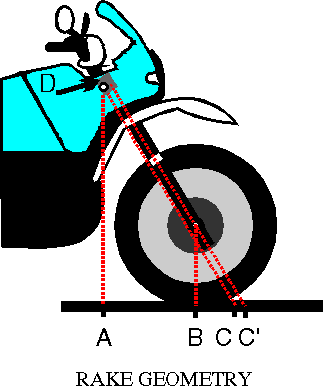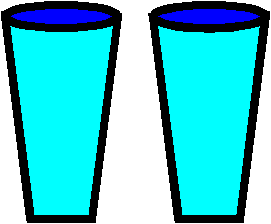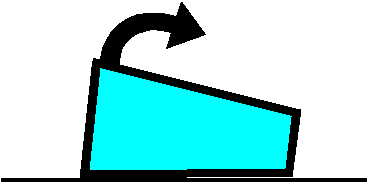
Riding Skills
Counter-steering
| Home | |
| Maintenance | |
| Riding Skills | |
|
By
James R. Davis
|
| Everyone who has driven
a motorcycle has experienced it, the MSF classes mention (but don't
explain) it, and motorcyclists discuss it all the time. But what is
it, really? How does it work? Why does it work? All questions I will
try to deal with in this discussion.
At very slow speeds we steer a motorcycle by turning the handlebar in the direction we wish to go. We can only do that at speeds of less than about 5 MPH. At any higher speed we do the exact opposite, whether we realize it or not. For example, assuming we want to turn to the right, we actually TRY to turn the handlebar left. This results in the front wheel leaning to the right and, as a result of the lean of the wheel, a turn to the right. This is counter-steering. Why is it that we don't get confused regardless of our speed? Because we have learned that steering a motorcycle is an effortless chore. That attempt to turn the handlebar to the left FEELS like we are pushing the right grip rather than pulling on the left one. It feels like that because the harder we push it, the more the motorcycle turns to the right and, thus, it feels like the right grip is pushing back at you that much harder. In other words, we quickly learn to associate counter-steering feedback with the hand closest to the direction in which we wish to turn. Further, even a little bit of experience shows that counter-steering is essentially effortless while trying to turn the handlebar in the direction you want to go is virtually impossible. Humans are relatively fast studies, after all. It takes only a modest familiarity with a gyroscope to understand counter-steering - at least to understand how most people believe it starts to work. The phenomenon is called Gyroscopic Precession. This is what happens when a lateral force is applied to the axis of a spinning gyroscope. The spinning gyroscope translates the force vector ninety degrees off the direction of spin. Thus, if we try to turn our front wheel to the left, the force we use appears as a lateral force forward against the axle on the right side and this is translated into a force that tries to lean the wheel to the right. Similarly, trying to turn the wheel to the right results in the wheel trying to lean to the left. But gyroscopic precession is not a necessary component of counter-steering. No matter how slight, if your front wheel deviates from a straight path your motorcycle will begin to lean in the opposite direction. It is entirely accurate to assume that even without gyroscopic precession, the act of steering the front wheel out from under the bike would start counter-steering in the opposite direction. This is a result of steering geometry - rake. You can observe it at a complete stop. Just turn your handlebars in one direction and you will see that your bike leans in the opposite direction as a result. In the case of a motorcycle, your handlebar input is immediately translated by gyroscopic precession into a lean in the opposite direction. Since your front wheel is attached to the bike's frame, the body of the bike also attempts to lean. It is the lean of the BIKE that overwhelms the handlebar effort and drags the front wheel over with it - gyroscopic precession merely starts the process and soon becomes inconsequential in the outcome. If, for example, you had a ski rather than a front wheel, the front would actually begin to turn in the direction of handlebar input (just like it does with a wheel instead of a ski) and body lean in the opposite direction would then overwhelm that ski making counter-steering still effective. The ONLY WAY to turn a motorcycle that is moving faster than you can walk is by leaning it (if it only has two wheels). We have talked only about what starts that lean to take place. Indeed, all we have talked about is the directional change of the front wheel along with the simultaneous lean of the bike, both in the opposite direction signaled by handlebar input. So then what happens? Before getting into what is actually somewhat complicated let me say that if you were to let go of your handlebars and provide no steering information whatever (or you were to get knocked off your motorcycle), after some wildly exciting swings from side to side your motorcycle would 'find' a straight course to travel in and would stabilize itself on that course, straight up! That's right, your motorcycle has a self-correcting design built into it - known as its Steering Geometry - that causes it to automatically compensate for all forms of leaning and speed changes and end up standing straight up, going in a straight line, whether you are on the bike or not - until it is traveling so slowly that it will fall down. Now please notice that the forks are not pointing straight down from the triple-tree, but are instead at an angle. This angle is known as the rake. Were it not for that rake (and modest offset) the front tire would touch the ground at point A. (Most rake angles are approximately 30 degrees.) What the rake does for you is profoundly important. For one thing, it causes any lean of the wheel to be translated into a turn of the wheel towards that lean. For another, it slows down your steering. That is, if you turn your handlebar 20 degrees at slow speed your course will change something less than 20 degrees. [At higher speeds you NEVER would turn your handlebars 20 degrees - the front wheel is always pointing virtually straight ahead.] Rake, in the case of higher speed turning then really does SLOW DOWN the realization of the turn. (We will see why soon.) Looking at the diagram, imagine that instead of pointing to the right the wheel is pointing straight at you. (The body of the motorcycle remains pointing to the right.) You will now recognize that the contact patch which was B before the wheel turned has now got to be near where C' is at. In other words, the fact that your wheel is on a rake results in the consumption of part of your steering input into a displacement of the contact patch of the wheel. (This is why steering is 'slower' - and the greater the rake, the slower it is. Note that 'slow steering' is NOT the same as 'under-steer'.) Notice also that where the red diagonal line marked C' touches the tire is higher than where B touches the tire. This demonstrates that a consequence of turning is that the front-end of your motorcycle actually lowers based on rake geometry. The distance between where B and C (not C') touch the ground is called trail. The more extreme the rake angle, and the shorter the offset, the longer the trail is. Some motorcycles will have the hub of the front wheel either above or below the forks rather than directly in the middle of them. In effect, these placements are designed to reduce or increase the effect of the offset in order to increase or reduce trail. The stability of your motorcycle at speed is a function of how long its trail is. However, have you ever noticed that the front wheel on bikes that have excessive rakes (and therefore long trail) have a tendency to flop over (at low speeds) when they are not aligned perfectly straight ahead? This is the phenomena that explains just one of the reasons why your wheel actually turns in the direction you want to go after it begins to lean in that direction. Any lean whatever of the wheel, because gravity tries to lower the front-end, receives an assist from gravity in its efforts to move the contact patch forward along the trail. Further, notice that the pivot axis of your forks is along C, not C' and that this is behind the bulk of the front-end. Thus, gravity plays an even bigger role in causing the wheel to turn than at first glance it would appear. (And now you see why you have steering dampers - so that a little lean doesn't result in a FAST tank-slapping fall of the wheel in the direction of the lean.) But there is another, more powerful, reason that the lean is translated into a turn - Camber Thrust. Unlike automobile tires, your motorcycle rides on tires that are rounded instead of flat from side to side. When you are riding vertically your contact patch is right in the middle of the tire, at its farthest point from the hub of the wheel. When you are leaning you are riding on a part of the tire that is closer to the hub of the wheel. The farthest parts of the tire from the hub of the wheel are TURNING FASTER than any part closer to that hub. Thus, when you are leaning the outside edge of the contact patch is moving faster than is the inside edge.
So, now you know what counter-steering is, how it works, and why. What might just now be occurring to you is with all of these forces conspiring to cause the wheel to lean and then turn in the direction you want to go, what stops that wheel from going all the way to a stop every time a little counter-steer is used? And, as I earlier mentioned, how does a pilotless motorcycle automatically right itself? The answer to both of those questions is centrifugal force and, again, rake geometry. For any given speed and lean combination there is only one diameter of a circle that can be maintained. This is a natural balance point at which gravity is trying to pull the bike down and centrifugal force is trying to stand it up, both with equal results. (If you have Excel on your system you might want to click on this link for a model that demonstrates this concept.) If the speed is increased without a corresponding decrease in the diameter of the turn being made, centrifugal force will try to stand the bike more vertically - i.e., decreases the lean angle. This, in turn, decreases the camber thrust and the bike will, of its own accord, increase the diameter of the turn being made. If the speed had been held constant but the bike attempts to shorten the diameter of the turn beyond that natural balance point then centrifugal forces are greater than gravity and it stands taller, again lengthening the diameter of the turn as described earlier. Once your bike is stable in a curve (constant speed and constant lean) then it will stay that way until it receives some steering input. i.e., you again use some counter-steering or the road surface changes or the wind changes or you shift your weight in some way or you change speed. As soon as any form of steering input occurs the stability of the bike is diminished. Momentum, camber forces and rake geometry will then engage in mortal combat with each other which will, eventually, cause the motorcycle to find a way to straighten itself out. That momentum will try to keep the motorcycle going in a straight line is obvious, but it also works with traction in an interesting way. That is, because the front tire's contact patch has traction the momentum of the entire motorcycle is applied to the task of trying to 'scrub' the rubber off that tire. If the body of the motorcycle is aligned with the front tire (only possible if traveling in a straight line) then there is essentially no 'scrubbing' going on. But if the bike is not in perfect alignment with the front tire, then momentum will try to straighten the wheel by pushing against the edge of that contact patch which is on the outside of the curve. As the contact patch touches the ground somewhere near point B, and because that is significantly behind the pivot axis of the front-end (red-dashed line C), the wheel is forced to pivot away from the curve. I believe you now see why if the bike were to become pilotless it would wildly gyrate for a few moments as all of these conflicting forces battled each other and the bike became stable by seeking a straight path and being vertical. Clever, these motorcycle front-end designers. No? |
| Copyright © 1992-2001 by The Master Strategy Group, all rights reserved |
 This
diagram shows a typical motorcycle front-end. The handlebars are
connected to the steering column, which is connected to the knee
bone, which is... Oops, wrong discussion. The steering column (actually
called the 'steering stem') does not connect to the knee bone, nor
does it connect directly to your forks! Instead, it connects to
what is known as the triple-tree (shown as D
in the diagram.) This is merely where both forks are tied, along
with the steering stem, to the bike's frame. You will notice that
the triple-tree extends towards the front and that as a result the
forks are offset forward some distance from the steering stem. (Notice
the red diagonal lines marked C and C'.) This is known
as the offset.
This
diagram shows a typical motorcycle front-end. The handlebars are
connected to the steering column, which is connected to the knee
bone, which is... Oops, wrong discussion. The steering column (actually
called the 'steering stem') does not connect to the knee bone, nor
does it connect directly to your forks! Instead, it connects to
what is known as the triple-tree (shown as D
in the diagram.) This is merely where both forks are tied, along
with the steering stem, to the bike's frame. You will notice that
the triple-tree extends towards the front and that as a result the
forks are offset forward some distance from the steering stem. (Notice
the red diagonal lines marked C and C'.) This is known
as the offset.
 Imagine
taking two tapered drinking glasses and putting them together as
in the next diagram. Does this not bear a striking resemblance to
the profile of your tires when looking at them head on?
Imagine
taking two tapered drinking glasses and putting them together as
in the next diagram. Does this not bear a striking resemblance to
the profile of your tires when looking at them head on?
 Now
imagine placing one of those glasses on its side on the table and
giving it a push. Note that the glass MUST move in a circle because
the lip of the glass is moving faster than any other part of it.
The same is true of your tires. This camber thrust forces your wheel
to turn in response to a lean.
Now
imagine placing one of those glasses on its side on the table and
giving it a push. Note that the glass MUST move in a circle because
the lip of the glass is moving faster than any other part of it.
The same is true of your tires. This camber thrust forces your wheel
to turn in response to a lean.
 Thus,
both the rake geometry and camber thrust conspire to cause a leaning
front wheel to become a turn in the direction of the lean. Then,
of course, the motorcycle body follows the wheel and it, too, leans
in the direction of the turn.
Thus,
both the rake geometry and camber thrust conspire to cause a leaning
front wheel to become a turn in the direction of the lean. Then,
of course, the motorcycle body follows the wheel and it, too, leans
in the direction of the turn.